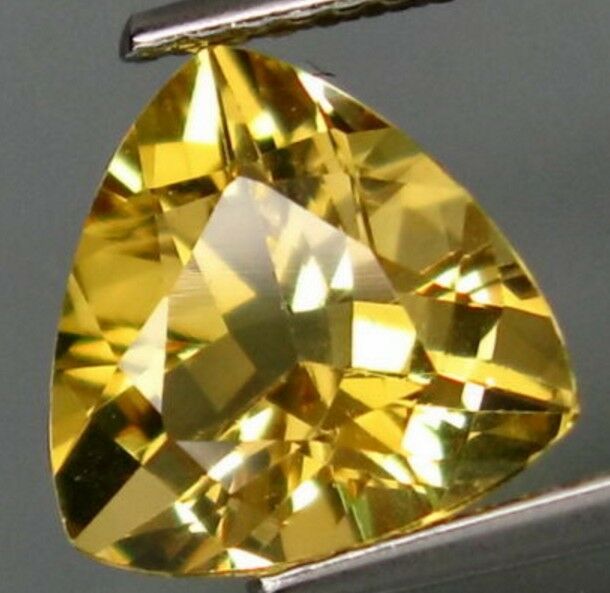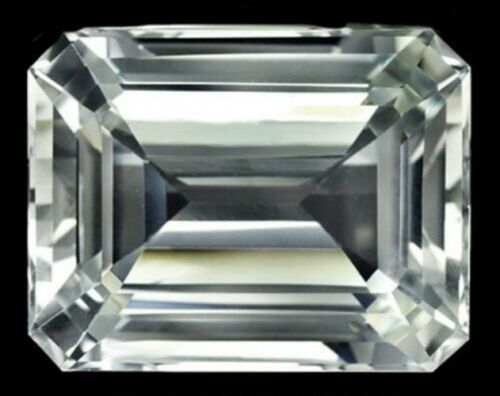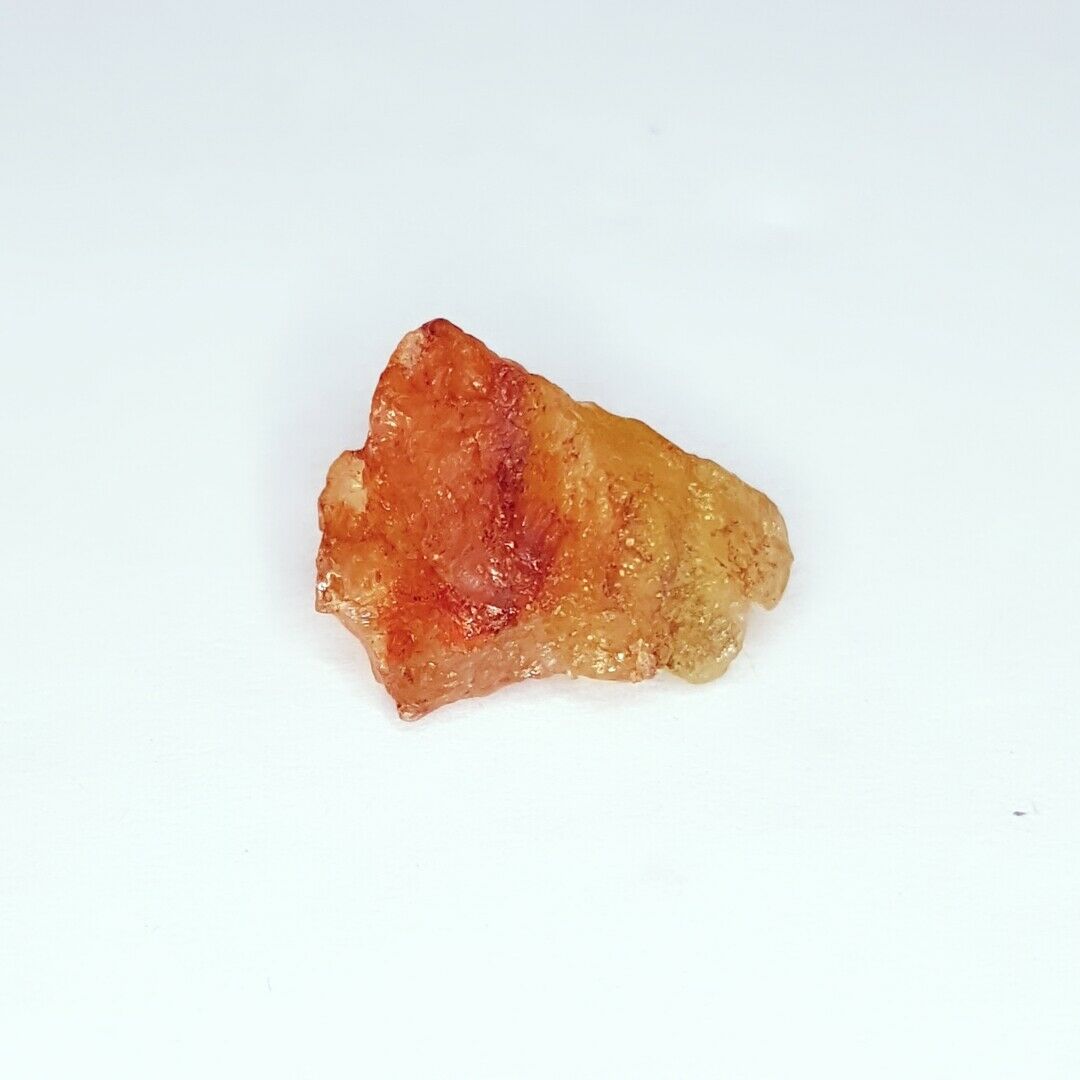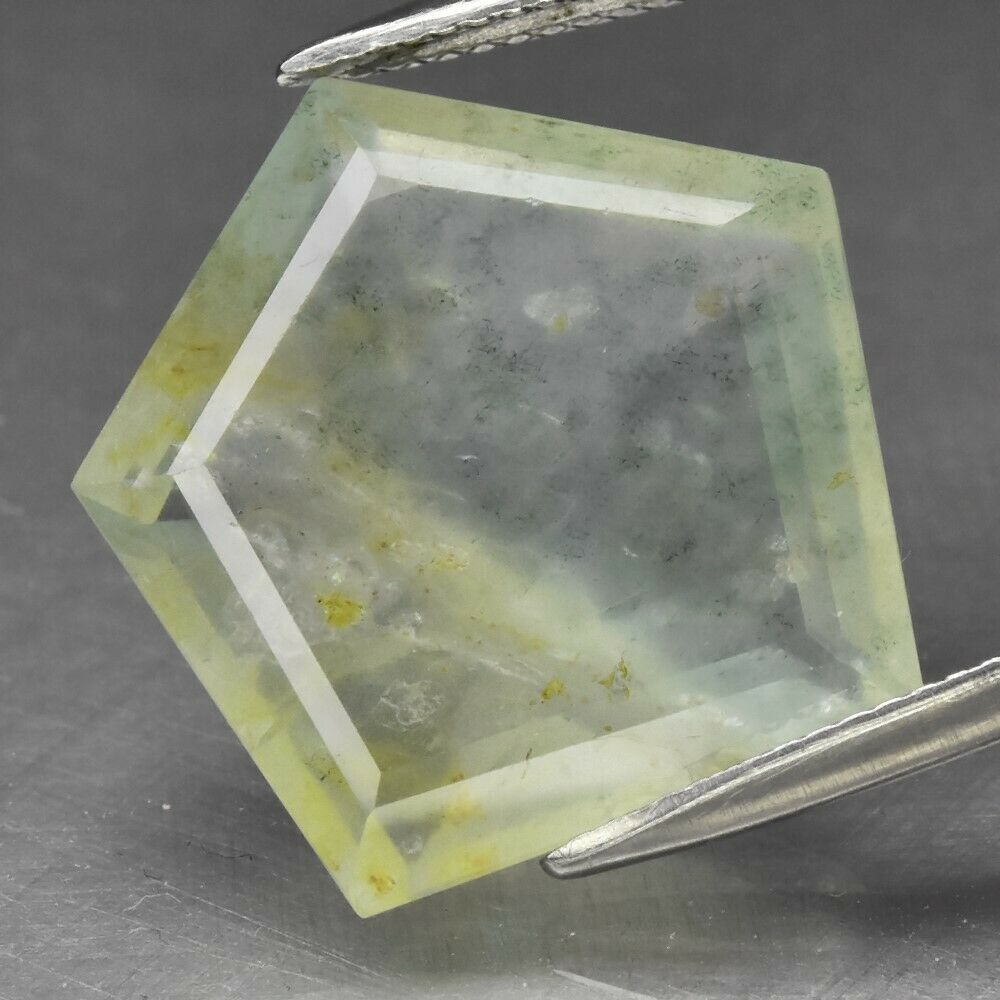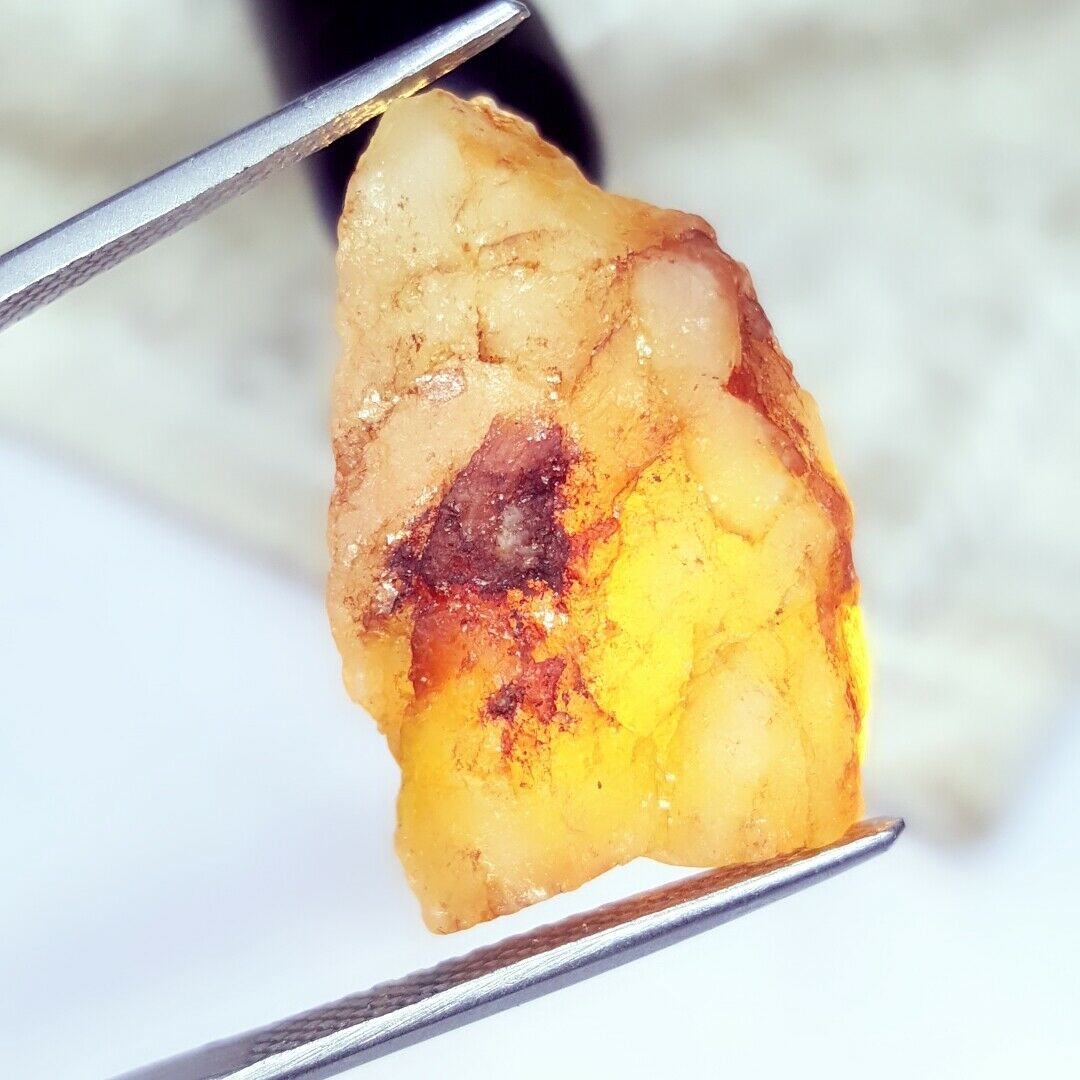-40%
2.50 cts Natural Trillion-cut Golden-Yellow VVS/IF Heliodor (Yellow Beryl)
$ 211.2
- Description
- Size Guide
Description
2.50 cts Natural Trillion-cut Golden-Yellow VVS/IF Heliodor (Yellow Beryl)New without Tags. This gem has never been used/placed/set in a setting.
It is utterly undamaged, unmarred and in perfect condition as expected of NWOTags.
I have included two Heliodor/Beryl articles below for your appreciation and enjoyment.
Summary of below:
"Additional deposits of
golden beryl
have been discovered in Brazil and Madagascar and these gems are now widely available. They tend to have excellent clarity and can often be found in larger sizes. The use of the term "heliodor" seems to have declined somewhat, and there is in fact some disagreement over the uses of the terms "heliodor" and "golden beryl."" ... "
Golden beryl is almost always untreated.
"
Type: Natural Heliodor (beryl)
(personally confirmed as a Genuine Heliodor by digital refractometer (RI=1.582), dichroscope (dichroic), polariscope (two complete flashes in a 360 rotation), spectroscope, UV short&long-wave light, measured Specific Gravity=2.69) -- captej2012
Shape: Trillion-cut
Weight: 2.50 cts
Size: 9.60mm x 9.60mm x 5.50mm
Color: Golden Yellow
Clarity: VVS/IF
Luster: Flashing Fire
Hardness: 7.0-8.0 on the Mohs Scale
Origin: Brazil
Treatment: Not Heated, Not-Enhanced, Not-Treated
The Kids were Young when W
e called the Sun
Big-Bright
.
When Such are the Sentiments to be
Stored in a Stone,
What Better than the Sparkling Magic of a
Heliodor
?
I brought
Big-Bright
home to Contain the Moments.
Moments when Family was their Only World.
When Innocence, a Chance for Wonder.
When Laughter, a Note of Joy.
When Song, a Lack of Fear.
Big-Bright
saw My Love drive me in Everything
.
I Worked and Gave My All for Family.
Still could I have Done Better and Provided More?
Big-Bright
says
"Nay, One's Best is All Any Can Do."
We are now an eBay eStore enterprise focused on selling mostly Loose Natural Gemstones. Stay here, look around and learn. Via eBay Messaging, ask us questions, make an offer, and otherwise discuss your wishes, concerns and hopes. We pride ourselves as good-spirited folks having fun and doing our best to share the joy of Nature's most beautiful and enduring literal treasure -- Natural Gemstones. Expect to find us cheerful and trustworthy, and we will expect the same of you. For us, Negative FeedBack as a means of coercion is never needed and only degrades everyone's enjoyment in what should otherwise be a fun shopping experience. And finally, please enjoy my work as eBay's First (unofficial) Gemstone Poet. -- captej2012
====================================================================================
Heliodor or Golden Beryl
Beryl from Madagascar
Most gem buyers are well acquainted with the most famous members of the
beryl family
--
emerald
and
aquamarine
. Some are also familiar with the salmon pink beryl known as
morganite
(after the American banker and gem collector,
J.P. Morgan
). But there is a lesser known member of the beryl family which is actually the most available and affordable:
golden beryl
.
The first major deposit of the yellow golden beryl was found in Namibia in 1913 by a German mining company. They named it
heliodor
from the Greek for "gift from the sun," and hired a famous designer, Lucas von Cranach, to create a fabulous set of jewelry for Kaiser Wilhem II of Germany and his wife. Heliodor gained international fame as a result, but it proved to be shortlived as the war intervened. Heliodor was soon forgotten.
Additional deposits of
golden beryl
have been discovered in Brazil and Madagascar and these gems are now widely available. They tend to have excellent clarity and can often be found in larger sizes. The use of the term "heliodor" seems to have declined somewhat, and there is in fact some disagreement over the uses of the terms "heliodor" and "golden beryl."
According to one well-known gemological reference (Walter Schumann,
Gemstones of the World
), the term heliodor refers to the light yellow-green color of beryl. However, Schumann goes on to note that "since there is no clear distinction possible in the yellow and green-yellow tones in comparison to golden beryl, heliodors are generally rejected as an independent precious beryl variety and rather are counted among the weak-colored golden beryls."
Heliodor Golden Beryl Rough
Golden beryl has a hardness of 7.5 to 8 on the
Mohs scale
, so it is suitable for all kinds of jewelry. Golden beryl colors range from the weak yellow-green of heliodor to lemon-yellow and golden-yellow. The coloring agent is iron.
Golden beryl
deposits have been found in Brazil, Madagascar, Namibia, Nigeria, Sri Lanka and Zimbabwe. Probably the largest cut golden beryl in the world is the flawless 2,054 carat stone on display in the Hall of Gems in the Smithsonian Institution in Washington, D.C.
====================================================================================
Beryl Gemstone Information
About Beryl - History and Introduction
Beryl is one of the most important mineral groups. It is abundant, but rarely occurs in transparent gem-quality material. Transparent specimens are referred to as 'precious beryl'. The most famous member of the
beryl family
is green
emerald
, followed secondly by
blue aquamarine
. Even though beryl is one of the most important mineral groups, golden beryl is not very well-known by the general public. Other popular beryls include pink '
morganite
' and white, or colorless, '
goshenite
'. Red beryl is the rarest variety of beryl and it is known in the trade as '
bixbite
'.
Golden beryl
is sometimes referred to as '
heliodor
', but many argue that heliodor and golden beryl are not the same gem. Heliodor is typically used to describe lighter, weaker colored greenish yellow beryl, while 'golden beryl' is reserved for vivid and intense lemon-lime like specimens. However, since there is no official distinction, heliodor and golden beryl are usually considered to be one and the same. Nowadays, the trade name of heliodor is rarely used.
Beryl in its purest form is completely colorless (goshenite). Trace impurities and coloring agents within colorless beryl are responsible for the many different colored varieties of beryl. Golden beryl's color is owed to iron impurities. Without trace elements and impurities, beryl would be rather ordinary and average, except for its superior hardness.
World-Famous Beryl
In 1913, the first significant deposit of golden beryl was discovered in Namibia by a German mining company. The material discovered was named 'heliodor', a word derived from the Greek language meaning 'gift from the sun'. Lucas von Cranach, one of the era's most prestigious jewelry designers, was asked to create an exquisite jewelry set for the then current German Emperor and King of Prussia, Kaiser Wilhem II. It was because of this fantastic exposure that golden beryl earned its fame as a precious gem. However, soon after the war, heliodor was almost completely forgotten about. One of the world's largest cut beryl stones is a 2,054 carat flawless, golden colored beryl. The exquisite gem is currently on display in Washington D.C.'s, "Hall of Gems", located within the Smithsonian Institution.
Beryl
Click to enlarge image
Identifying Beryl
There are a number of different gems that bear similar resemblance to golden beryl, including apatite, quartz, feldspar, topaz and tourmaline. However, beryl can usually be easily identified and distinguished from similar gems through basic testing. One of the easiest methods to identify beryl is by testing
specific gravity (density) and hardness
. Beryl is significantly harder than apatite, quartz and feldspar, but slightly softer than topaz.
Beryl, topaz and tourmaline also have very different crystal systems and formations. Tourmaline's crystal structure is usually heavily striated; topaz has perfect cleavage and eight-sided striations, whereas beryl has a distinct six-sided hexagonal crystal structure which makes it very easily identifiable.
Beryl Origin and Gemstone Sources
Beryl specimens from Brazil are known to be of the highest quality. Brazilian beryl typically exhibits excellent clarity and specimens from Brazil tend to be much larger than other sources. Other significant mining locations include Madagascar, Namibia, Sri Lanka (Ceylon), Nigeria and Zimbabwe. Aquamarine, the
birthstone for March
, is also sourced mainly from Brazil and
Karur, India
.
Buying Beryl and Determining Beryl Gemstone Value
Beryl Color
Precious beryl occurs in a variety of colors. The greenish-yellow colored variety is referred to as heliodor or golden beryl. Golden beryl is the most common gem-quality variety of beryl. Colors range from vivid lemon-lime to pale greenish-yellow to golden in color. Golden beryl, or heliodor, owes its color to iron impurities. Beryl can also display ranging levels of
pleochroism
.
Beryl Clarity and Luster
Beryl can naturally occur in a range of clarity levels from transparent to opaque. Gemstone-quality beryl is transparent. Inclusions are rare for golden beryl and specimens are almost always eye-clean. When cut and polished, golden beryl has an attractive vitreous to waxy luster.
Beryl Cut and Shape
Golden beryl is usually faceted to display its brilliance. It is not typically cut en
cabochon
, unless it possesses asterism (star effect) or chatoyancy (cat's eye effect). Golden beryl is available in a variety of shapes and cutting styles, including
Portuguese cuts and checkerboard cuts
. Traditional shapes are most common, including ovals, pears, rounds and cushions, and fancy shapes are also readily available, such as trillions, hearts,
briolettes
and
flower cuts
. Beryl is an excellent material used frequently for gemstone carvings and ornamental designs.
Beryl Treatment
Golden beryl is almost always untreated. Pink and white, colorless beryl is not typically treated. Some
aquamarine
stones may be enhanced with light heat treatment, while emerald is almost always treated with oil resin.
